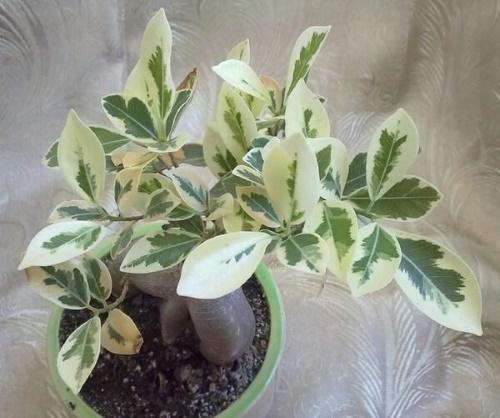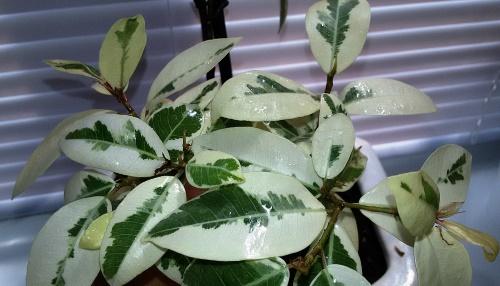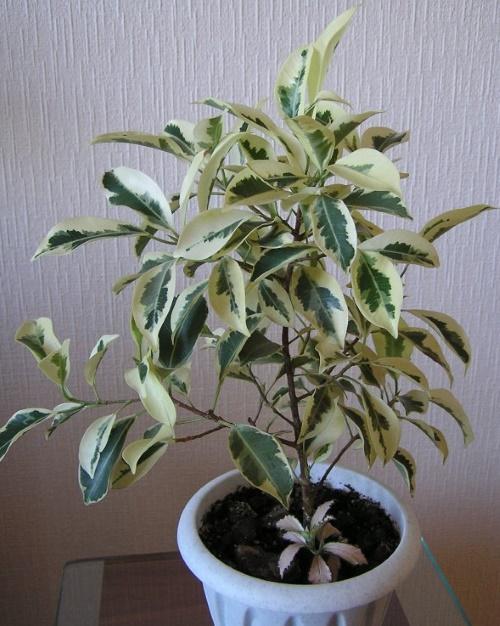Ficus albumarginata - a variegated handsome man on your window
 Among the decorative indoor plants, ficuses occupy a special place due to the spectacular appearance of a lush deciduous cap. One of the most beautiful varieties of this plant is the ficus albumarginate. Its unusual coloring is pleasing to the eye and distinguishes the bush against the background of other green-leaved flowers.
Among the decorative indoor plants, ficuses occupy a special place due to the spectacular appearance of a lush deciduous cap. One of the most beautiful varieties of this plant is the ficus albumarginate. Its unusual coloring is pleasing to the eye and distinguishes the bush against the background of other green-leaved flowers.
Description of the plant

Like the rest of the microcarp, the highlight of the culture is the original structure and development of the root system. At a young age, ficus is no different from other bushes. A slender stem with a dense crown flaunts in the pot. But over time, the upper part of the roots begins to rise above the soil, thickens and takes on a bizarre shape. Moreover, each tree has its own, and there are no two completely identical plants.
But you can recognize the albumarginate by the leaves. Smooth, elliptical, with a slightly pointed tip and chic gloss, they are almost white with a fancy green pattern. Moreover, each sheet has its own. Only one along the central vein has thin green streaks. Another green leaf may have the tip of the plate or one half of it.
Ficus albumarginate: features of cultivation and care
 The variegated form of the plant loves light, warmth and moisture. Unlike varieties with a green color, which prefer semi-shady places, it is better to put the albumarginate on a light window. It's good if this is the eastern part of the house. The southern window is not suitable for this purpose, since the ficus does not like direct rays. The main requirement for the temperature regime is its stability. The plant prefers a temperature of about 25 °, but sharp fluctuations will immediately affect the leaves, which will begin to fall off.
The variegated form of the plant loves light, warmth and moisture. Unlike varieties with a green color, which prefer semi-shady places, it is better to put the albumarginate on a light window. It's good if this is the eastern part of the house. The southern window is not suitable for this purpose, since the ficus does not like direct rays. The main requirement for the temperature regime is its stability. The plant prefers a temperature of about 25 °, but sharp fluctuations will immediately affect the leaves, which will begin to fall off.
In winter, it is necessary to ensure that the ficus was warm "in the legs". The pot must be placed on a stand so that it does not stand on a cold windowsill.
Caring for the album arginate as a whole is not particularly difficult:
- Given the moisture-loving culture, it is necessary to water the tree all year round. The frequency of watering depends on the season. In summer, it is necessary to moisten the soil abundantly at least 2 times a week. In winter, one watering every 7 days may be enough, but it all depends on the climate in the house.
- Loves ficus and moist air, so it should be sprayed daily. You can also periodically wipe the leaves with a damp sponge.
- For active growth, the plant needs additional fertilizing, and it is desirable to carry them out all year round. From spring to early autumn, mineral complexes should be applied 2 times a month. From the end of autumn to the end of winter, it is enough to feed the ficus once a month, but at the same time reducing the concentration by half.
- To give the tree the desired shape and to obtain its characteristic thick trunk, it should be trimmed in spring and autumn. Scheme trimming depends on how you want to see the ficus. In general, you need to shorten the stem itself in young bushes and shoots, stimulating their branching.
Albumarginate does not need frequent transplants, since it grows slowly, and it does not tolerate them well. It is enough to carry out this procedure every three years, the rest of the time, just renew the topsoil.